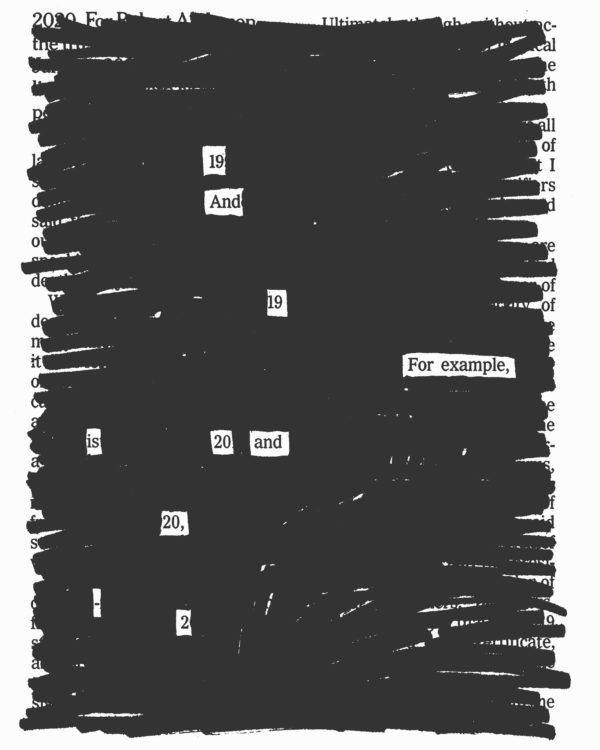
I made this blackout after observing my wife teach my kids math out of a workbook that uses techniques that confuse our Elder Millennial brains. Here’s a decent explanation for why Common Core math problems look so weird:

I made this blackout after observing my wife teach my kids math out of a workbook that uses techniques that confuse our Elder Millennial brains. Here’s a decent explanation for why Common Core math problems look so weird:
Here is a photograph of the chalkboard at the end of one of Marc Weidenbaum’s classes. He says a lengthy classroom discussion of “what sound looks like” led to “this mid-period Basquiat.”
I just love looking at these markings. Weidenbaum has posted a few whiteboards on his site, but they just don’t have the same magic.
What is it about chalk?
Photographer Jessica Wynne has posed exactly that question with her series of photos Do Not Erase, which capture the chalkboards of mathematicians across the world.
From the NYTimes profile, “Where Theory Meets Chalk, Dust Flies”:
“I am attracted to the timeless beauty and physicality of the mathematicians’ chalkboard, and to their higher aspiration to uncover the truth and solve a problem,” Ms. Wynne said in an email. “Their imagination guides them and they see images first, not words. They see pictures before meaning.”
She added: “I am also fascinated by the process of working on the chalkboard. Despite technological advances, and the creation of computers, this is how the masters choose to work.”
In their love of blackboards and chalk, mathematicians are among the last holdouts. In many fields of science and investigation, blackboards have been replaced with whiteboards or slide show presentations. But chalk is cheaper and biodegradable. It smells better than whiteboard markers and is easier to clean up, mathematicians say. It is also more fun to write with.
Only chalkboards will do:
Wynne says she deliberately shunned whiteboards, or digital boards. “I like the timelessness about blackboards,” she says, adding that they are also intriguing for their capacity to show layer upon layer of working.
There’s something about having the space to think:
The sheer size of blackboards, ranging from single wall affairs to extensive, multi-panel boards, is important. “It is this giant canvas,” says Wynne. “Seeing everything in one large piece, you can jump around on the board and connect pieces and take things away and add things… I haven’t seen any other tool or any other device that matches that experience.”
And there’s something about the chalk itself.
In this video, “Why The World’s Best Mathematicians Are Hoarding Chalk,” mathematicians discuss why they’re so obsessed with Japanese chalk from the brand Hagoromo.
“There’s a real value to this,” one mathematician says, holding up a stick. “But the value is in using it up. Not hoarding it.”
So, yeah: chalkboards, man. I mean, even the erased boards are beautiful…
* * *
Previously on the blog: chalkboard drawings by artists

One of my favorite things about Tibor Kalman’s monograph, Perverse Optimist, is how much he talks about his kids. He dedicated the book “for my children who have made me change my mind about everything.” Later he writes, “Your children will smash your understanding of knowledge and reality. You will be better off. Then they will leave. You will miss them forever.” The greatest benefit of having children, he said, “has been to look at the world through their eyes and to understand their level of curiosity and to learn things the way they learn things.”
Some friends of ours are about to have their second kid, and I was thinking about what a leap it is between 1 and 2, how many parents say “it’s exponential,” but how I never really understood why until I drew the diagram above and was able to really see all those relationships mapped out.
“We chose to increase the complexity of our lives by having children,” Kalman writes. That’s really it. With each kid, your household becomes increasingly complex.
It’s not lost on me that when you switch “complex” from an adjective to a noun, it means a network, or “a group or system of different things that are linked in a close or complicated way.” In psychoanalysis, a complex is “a related group of emotionally significant ideas…that cause psychic conflict leading to abnormal mental states or behavior.” In chemistry, a complex is “any loosely bonded species formed by the association of two molecules.” All of those things sound like my family.
More moving parts, more complexity.
This site participates in the Amazon Affiliates program, the proceeds of which keep it free for anyone to read.